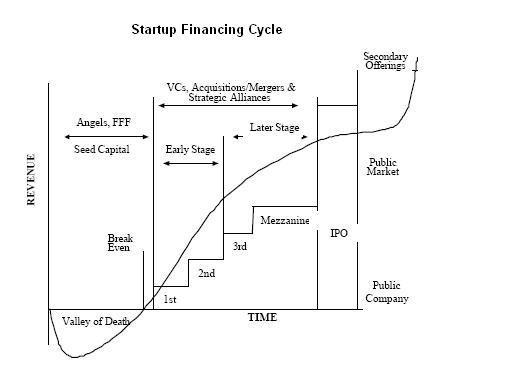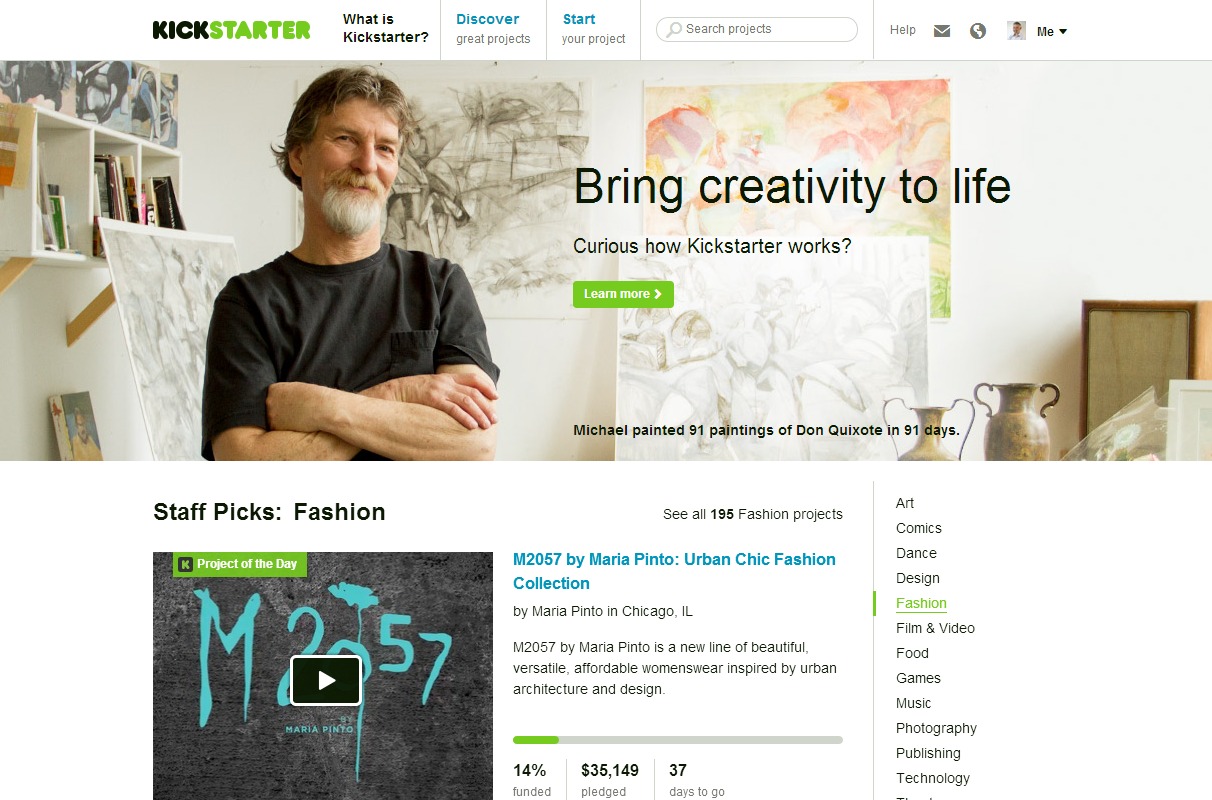
Startup financing cycle - Credit Wikipedia
Pitch your Startup, App or Hardware or post a Startup Event or Startup Job
Many people don’t think its possible to get a customer to fund your business, but it really is, especially where you have a product or service that is not a commodity.
Recently when mentoring a startup I suggested this and they were shocked, they didn’t believe it was possible, however some months later they had managed to get one of their new business customer to accept the idea of paying upfront for the still to be completed product (and the revenue arrived before the fundraising they were holding out for).
Many entrepreneurs are stuck hoping and wishing they can raise capital, truth of the matter is it can take 3-12 months to raise your first round (or never), customer revenue on the other hand could only be a few weeks away.
If you are solving a difficult problem and you can convince a few customers you have a compelling new solution (albeit with some rough edges) there is every likelihood that you can convince them to pay up front or pay to develop additional features that meet their needs (which hopefully just happen to be in your roadmap).
This concept is missing from the Startup Financing Cycle graph above and there is every chance that tapping your customers for finance will get you through the Valley of Death or at the very least reduce the amount of capital you need to raise and allow you to retain more equity.
Given you can only grow a business as quickly as you can turn cash (I will go into more depth on how to accelerate your funding later in the 10 Ways to Kickstart your Startup series) bringing revenue forward by getting customers to pay upfront is much more common than you might believe.
Kickstarter is the modern consumer incarnation of this method but it has happened for as long as companies have existed, Kickstarter has just found a mostly frictionless method to facilitate this on a global scale and connect non businesses or would be startups and consumers.

When I started my first business I would insist on payment in advance, we turned over $4m in our first full financial year so I simply didn’t have the cash to fund this and there was no other way for me to do business.
Surprisingly very few people actually rejected this, especially when you explained to them that you were growing so quickly this is the only way you could fund the growth. You have to be ready to be a bit embarrassed about this, but you have to suck it up as it may be the only way for you to succeed.
I am not anti Venture Capital, quite the opposite, however I tell most Startups I meet that their ability to retain their equity is a function of how much pain they are willing to put up with and they are better off turning to VC when they are growing so quickly they can’t fund the working capital required to support the growth, which is a fantastic position to be in.
So a few suggestions on how to do this (primarily for the business market)
- If you are selling a new technology or type of product, explain to the customer exactly what stage you are at, show them the product, tell them what the risks are and what your plan is, assuming you meet their previously unmet needs and they trust you and they can see the product is going to work for them, ask them for a deposit or get them to place and pay for an order. If the tech guy tells the purchasing and finance guy this is the only way to get the problem solved then often they will simply pay you, it’s amazing to see this turn up in your bank account.
- If you are selling an existing product and its a large order (above your financing capacity) ask the customer what you can do to make the deal more attractive, for example is there an extra service you could throw in if he can pay upfront, something that might save their team a lot of time but might not take your team much time, or can you coordinate a late night or weekend install/upgrade?
- If you are selling a service ask for a commencement fee.
- If a customer has a particular need, tell them you are happy to build it to their requirements if they can fund NRE (Non Recurring Engineering) costs. Ideally the feature you develop will be part of your roadmap and you have managed to get the customer to help fund your development costs.
- In large roll-outs, get customers to pre-purchase and pay for large orders and release it from your stock as they need it. It’s pretty easy to convince them you will keep it ready for them and they don’t have to worry about delays, you get paid both for the cost of the product and your profit (if you are working with a distributor, place an order on the stock and get it secured but ask them to only part ship for you, that way you only pay as you use it, but you have the customers cash, I will give an example of a sophisticated version of this below with Dells supply chain)
Dell

One of the best corporate examples of this is Dell. Dell gets paid in advance for the majority of their orders.
When you place an order you pay upfront via the Website (which everyone thinks is normal) but they don’t supply the product for another 7-21 days.
When you place your order they usually don’t even own the parts that they will use to build your product yet.
Here is how it works
- You place your order
- You pay upfront
- The order is sent to the factory
- The suppliers are required to be within 50km of Dells assembly plants and have their parts and trucks ready to go.
- Dell orders the parts to make the batch of product they are scheduling that day
- The supplier trucks are all lined up on one side or outside the plant.
- When the truck rolls across the plants threshold, Dell now owns the product (note, most companies are invoiced when a shipment leaves the supplier warehouse, not Dell, suppliers don’t get to invoice until it hits their assembly line).
- They assemble the PC and ship it to you
- They pay their suppliers in normal commercial terms of >60 days (according to an analysis of their accounts their average debtor days could be as much as 80 days http://www.mysmp.com/fundamental-analysis/days-payable-outstanding.html)
So if you can convince your customers to follow some or all off the above methods there is every chance you can get your startup off the ground and be doing business without seeking external funding. Good luck
As always I welcome questions and comments, leave a message below and I will respond
Related articles
Pitch your Startup, App or Hardware or post a Startup Event or Startup Job










